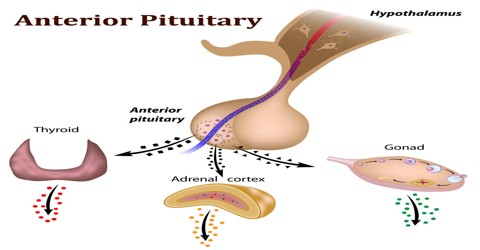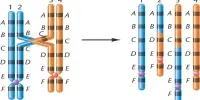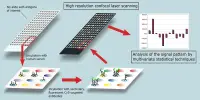Anterior Pituitary
Definition
Anterior pituitary is a gland at the base of the brain in vertebrate animals that is divided into two regions, anterior and posterior, each of which secretes important hormones. Hormones secreted by the anterior pituitary influence growth, sexual development, skin pigmentation, thyroid function, and adrenocortical function. These influences are exerted through the effects of pituitary hormones on other endocrine glands except for growth hormone which acts directly on cells.
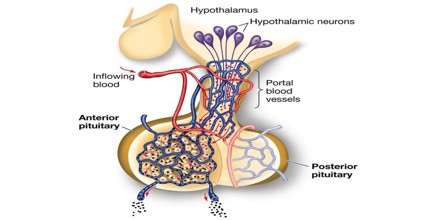
Growth hormone is also produced by the anterior pituitary. The posterior pituitary releases antidiuretic hormone (ADH) and oxytocin.
In the anterior pituitary there are 2 main different kinds of cells: acidophil and basophil, the names of the cells is due to the affinity of the colorant used in histochemistry (acid or basic colorant). Proper functioning of the anterior pituitary and of the organs it regulates can often be ascertained via blood tests that measure hormone levels.
Structure and Functions of Anterior Pituitary
The pituitary gland is a pea-sized gland that sits in a protective bony enclosure called the sella turcica. The hormones of the anterior pituitary are proteins that consist of one or two long polypeptide chains. TSH, LH, and FSH are called glycoproteins because they contain complex carbohydrates known as glycosides. The hormones of the anterior pituitary are synthesized in the cytoplasm of the cells as large inactive molecules called prohormones. The anterior pituitary is composed of three regions:

- Pars Distalis: The pars distalis contains two types of cells including chromophobe cells and chromophil cells. The chromophils can be further divided into acidophils (alpha cells) and basophils (beta cells). These cells all together produce hormones of the anterior pituitary, and release them into the blood stream.
- Pars Tuberalis: The pars tuberalis, (tubular part), forms a part of the sheath extending up from the pars distalis which joins with the pituitary stalk, also known as the infundibular stalk or infundibulum, arising from the posterior lobe.
- Pars Intermedia: The pars intermedia, (intermediate part), sits between the pars distalis and the posterior pituitary, forming the boundary between the anterior and posterior pituitaries. It is very small and indistinct in humans.
Each pituitary hormone plays a vital role in endocrine function. Thyrotropin stimulates the production of thyroid hormone. ACTH stimulates the production of cortisol and androgenic hormones by the adrenal cortex. FSH stimulates the production of estrogens and the growth of egg cells (oocytes) in the ovaries in women and sperm cells in the testes in men. LH stimulates the production of estrogens and progesterone by the ovaries in women and the production of testosterone by the testes in men. GH stimulates linear growth in children and helps to maintain bone and other tissues in adults. Prolactin stimulates milk production.
Types of Anterior Pituitary
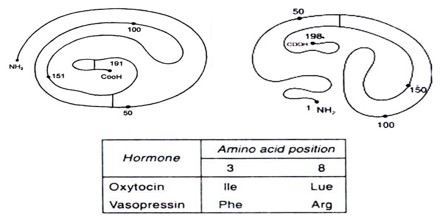
The anterior pituitary contains eight types of hormones:
- STH (Somatotrophic Hormone): STH is secreted from STH-cells of adenohypophysis. It is a peptide hormone. Its molecular weight is about 22 KD in all mammalian species. It is made up of 191 amino acid residues. This hormone promotes DNA, RNA and protein synthesis via insulin like growth factor in liver, chondrocytes, muscles and somatic cells.
- Prolactin or LTH / PRL: This hormone is secreted from LTH-cells of adenohypophysis. Prolactin is protein hormone. Its molecular weight is about 23 KD. It is made up of 198 amino acid residues. It has 3 disulfide bonds between cysteine residues at 4 and 11, 58 and 73 and 190 and 198. This hormone is stored in Golgi apparatus.
- Adrenocorticotropic Hormone (ACTH): It is a small peptide hormone. It is made up of single chain polypeptide consisting of 39 amino acid residues. Serine and phenylalanine present at N-terminal and c-terminal ends respectively.
- Thyroid Stimulating Hormone (TSH): This hormone is secreted from TSH cells of adenohypophysis. It is a glycoprotein hormone. Its molecular weight is about 30 KD. This hormone consists of two subunits α and β joined by non-covalent bonding.
- FSH: The hormone FSH is secreted from FSH cells of adenohypophysis. It is chemically made up of glycoprotein. Its molecular weight is about 34 KD. This hormone also consists of 2 subunits α and β.
- LH/ICSH: LH/ICSH is a glycoprotein hormone. Its molecular weight is about 29 KD. In female, it is called as LH, where as in male it is known as ICSH.
- MSH (Melanocyte Stimulating Hormone): MSH is secreted from pars inter-media of pituitary gland. It is also known as intermedin.
- Oxytocin and Vasopressin: Oxytocin and vasopressin are two neurohypophysial hormones. These two hormones are localized within the axonal endings. Each hormone is transported through axons in association with specific carrier protein, called neurophysins.
Effects of the Anterior Pituitary
The effects of underfunction of the anterior pituitary include growth retardation (dwarfism) in childhood and a decrease in all other endocrine gland functions normally under the control of the anterior pituitary (except the parathyroid glands). The results of overfunction of the anterior pituitary include overgrowth (gigantism) in children and a condition called acromegaly in adults.
